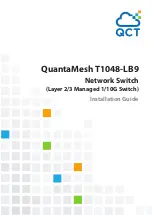
10
Table 2. LADS Connection Distances
Data Rate
Wire Gauge (AWG)
Data Rate
(kbps)
19
22
24
26
2.4
20.0 mi
(32.2 km)
16.6 mi
(26.7 km)
12.7 mi
(20.5 km)
9.4 mi
(15.1 km)
4.8
19.4 mi
(31.2 km)
12.7 mi
(20.5 km)
9.6 mi
(15.4 km)
7.1 mi
(11.5 km)
9.6
15.2 mi
(24.5 km)
9.7 mi
(15.6 km)
7.3 mi
(11.7 km)
5.6 mi
(9.0 km)
19.2
1
11.8 mi
(19.0 km)
7.5 mi
(12.1 km)
5.7 mi
(9.2 km)
4.2 mi
(6.8 km)
38.4
11.2 mi
(18.0 km)
6.5 mi
(10.5 km)
4.6 mi
(7.4 km)
3.2 mi
(5.1 km)
56
9.2 mi
(14.8 km)
5.4 mi
(8.7 km)
3.8 mi
6.2 km)
2.8 mi
(4.5 km)
64
9.2 mi
(14.8 km)
5.4 mi
(8.7 km)
3.8 mi
(6.2 km)
2.8 mi
4.5 km)
1
Power level is –10 dBm.
Connecting the DSU to a Router
The DualFlow DSU transmits user data through its V.35 interface and diagnostic or user
data through its EIA-232-D/V.24 interface. Cabling is based upon the preset
configuration (SyBC, SyBT, or DiDg) selected in the Opts subbranch (Config branch).
Follow this procedure to connect the DSU to a router.
Procedure
1. Connect the plug end of the router’s V.35 cable to the DSU’s V.35 connector.
Tighten the two holding screws.
2. Connect the other end of the router’s V.35 cable to the router’s primary serial port.
Tighten any holding screws.










































